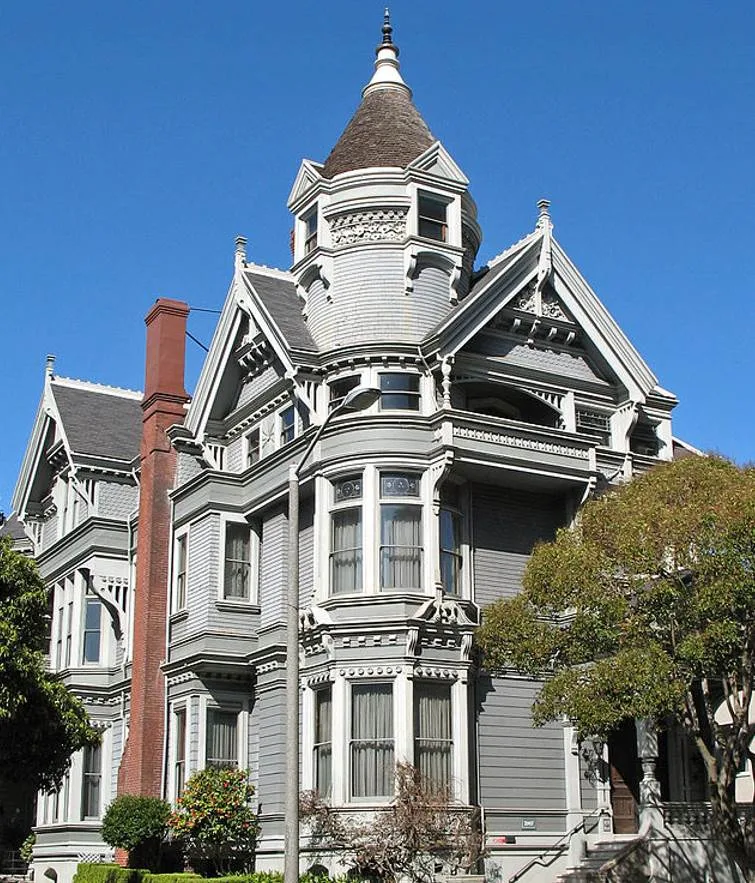A lot has happened since Don Gaspar de Portolá, a Spanish explorer, became the first European to visit the San Francisco Bay area in 1769.
Just 7 years later on June 29, 1776, Spanish colonists established the Presidio of San Francisco at the Golden Gate.
Today, San Francisco is a bustling city and the most important city in Northern California on the west coast of the United States.
Its metropolitan area is home to over 4.7 million inhabitants making it the 12th most populous metro in the U.S. It’s also one of the most popular tourist destinations in the country
In this post, we have compiled a list of the most famous buildings in San Francisco, architecture that you simply must see when you visit this amazing place!
1. Golden Gate Bridge
The Golden Gate Bridge isn’t just one of the most famous buildings in San Francisco, it’s an icon of the entire United States.
It’s arguably one of the most famous bridges in the world and has been ever since its opening in the year 1937.
This amazing structure connects the utmost northern tip of San Francisco with Marine County and carries U.S. Route 101 and California State Route 1 across the Golden Gate Strait.
It was the longest and tallest suspension bridge in the world upon completion with a main span of 4,200 feet (1,280 meters).

It’s also a very high structure as it has a maximum height of 746 feet (227 meters) above the water below.
Want to take some of the most amazing pictures of the city, the bridge, and San Francisco Bay, then visiting this amazing landmark should be on top of your San Francisco bucket list.
Official website: Golden Gate Bridge

2. Transamerica Pyramid
The Transamerica Pyramid is the most iconic skyscraper that dominates the San Francisco skyline, mainly because it has the shape of a four-sided pyramid.
The building is located on 600 Montgomery Street in the Financial District of San Francisco and was originally built to serve as the headquarters of the Transamerica Corporation, an American holding company.
It was the tallest building in the city upon completion with a height of 853 feet (260 meters), a record it held until 2018.
It remains the second-tallest skyscraper in the city today and has become an icon of the city since its completion.
A public park is located at the base of the tower which features redwood trees that were moved here from the Santa Cruz Mountains.
This in combination with the amazing view makes this a great place to hang out in the heart of the city.
Official website: Transamerica Pyramid
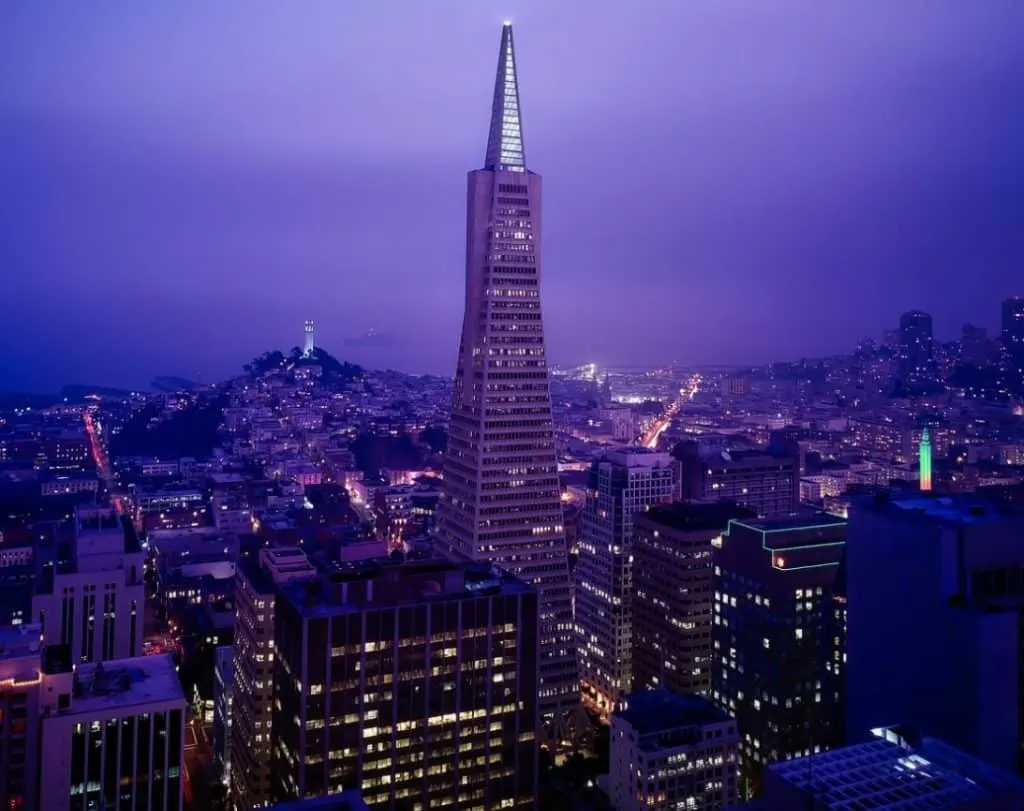
3. Alcatraz Island
Alcatraz Island is a small island located in San Francisco Bay that is infamously known for its federal prison.
It’s located just 1.25 miles (2.01 kilometers) offshore and even though it appears to be pretty easy to swim there, this is pretty much impossible because of the strong currents here.
This notorious prison was home to some of the most notorious criminals in the United States and it served this purpose from 1934 until March 21, 1963.
The island is now part of the National Park Service and a popular tourist attraction in San Francisco.
It welcomes visitors who want to get a glimpse of how life in Alcatraz prison was.
Other famous buildings on the island include the oldest operating lighthouse on the West Coast of the United States and military fortifications.
Official website: Alcatraz Island

4. Palace of Fine Arts
The Palace of Fine Arts is located in the Marina District of San Francisco and was originally constructed to exhibit art during the “1915 Panama-Pacific Exposition.”
The current buildings on the site were completely renovated and partially rebuilt between 1964 and 1974.
The centerpiece of the complex is an enormous open rotunda which is flanked by rows of colonnades and a lagoon.
It stands 162 feet (49 meters) high and is one of the biggest single-story buildings in the city. This makes it a must-visit attraction if you enjoy nice architecture.
The structure has been used as an exhibition center and for special events such as trade fairs and weddings.
Official website: Palace of Fine Arts
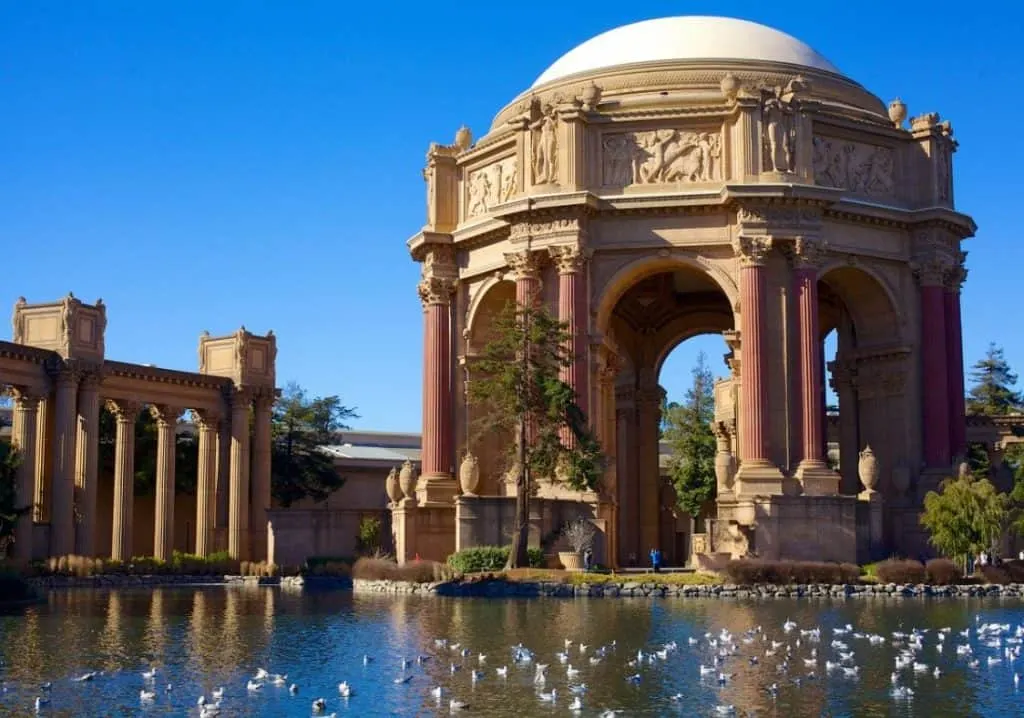
5. Coit Tower
Coit Tower is a fascinating tower located in the Telegraph Hill neighborhood of the city.
It’s situated in an elevated position which means that even though it only stands 210 feet (64 meters) tall, it provides amazing views of the city and surroundings of San Francisco.
The tower is the centerpiece of a park on top of the hill called “Pioneer Park” and was built between 1932 and 1933.
The construction was financed using the bequest of Lillie Hitchcock Coit, the patroness of the volunteer firefighters of the city.
It was built in honor of the firefighters who lost their lives during 5 major fires in the city and is therefore also known as the “Coit Memorial Tower.”
The tower has an observation deck and even though there are plenty of options to visit similar attractions in Downtown San Francisco, this one provides a unique view of the city.
The interior of the tower is decorated with murals worth checking out as well.
Official website: Coit Tower
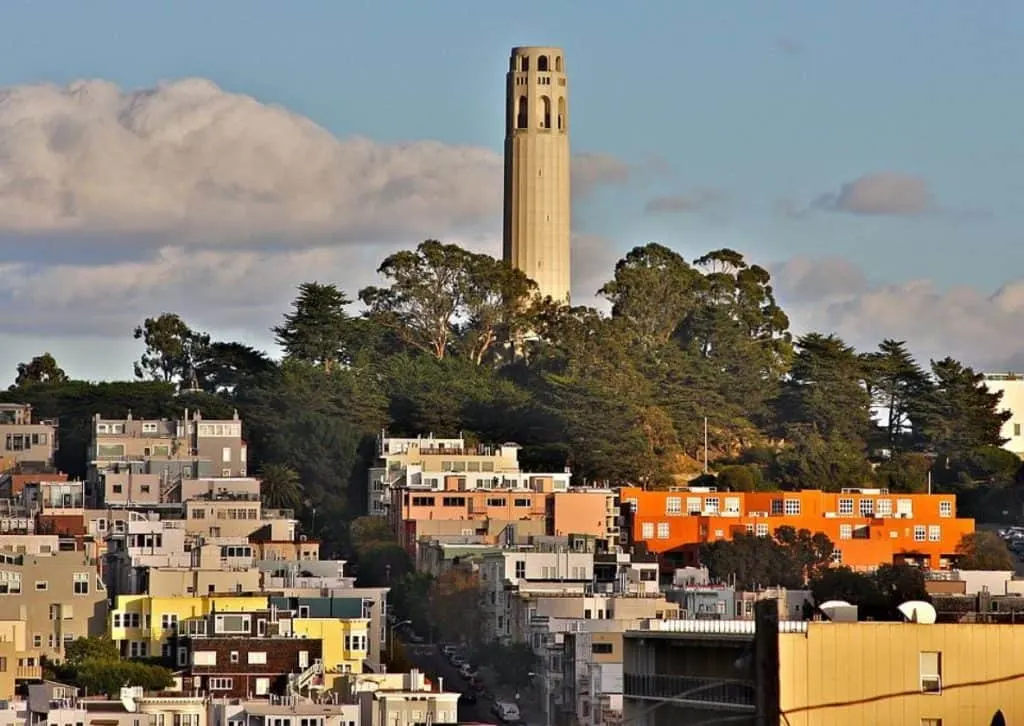
6. San Francisco Ferry Building
The San Francisco Ferry Building is a huge terminal for ferries that travel across the San Francisco Bay.
It’s located on the eastern waterfront of the port of San Francisco referred to as the “Embarcadero.” The building was designed in the Beaux-Arts architectural style in 1892 and completed in 1898.
It was the largest construction project in the city up until that time and is world-famous for its 245-foot-tall (75 meters) clock tower which features 4 clock dials of 22 feet (6.7 meters) in diameter.
The fact that it’s one of the few major buildings that survived the devastating earthquake of the early 20th century is quite remarkable as well.
This clock tower was modeled on the Giralda bell tower, the tower of the Seville Cathedral in southern Spain.
Today, the building serves as a large indoor marketplace and has become one of the most popular attractions for both tourists and locals.
Official website: Ferry Building Marketplace
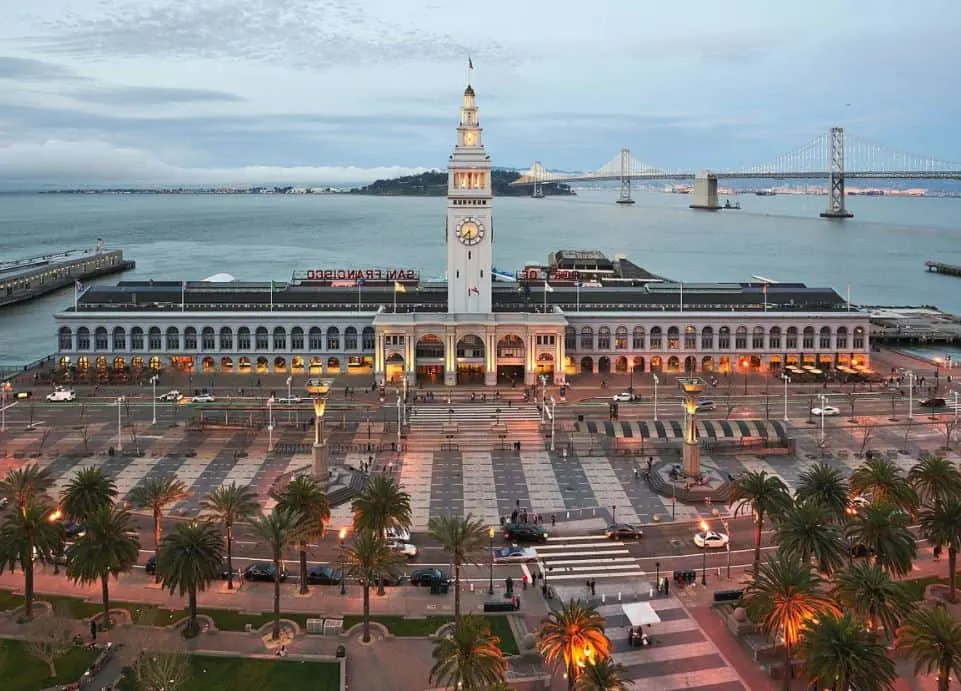
7. Palace Hotel
The Palace Hotel is a historic hotel in the city located on the southwest corner of Market and New Montgomery streets.
The current building is sometimes referred to as the “New Palace Hotel” because the original building, which was completed in 1875, was destroyed by the 1906 earthquake and subsequent fire and completely demolished shortly after.
The construction of the new building started shortly after and was completed in the year 1909.
It has been the venue for some of the city’s most important events and the “Garden Court” is considered to be one of the most exclusive dining areas in the city.
The hotel is also a member of Historic Hotels of America and is without a doubt one of the most fascinating hotels to spend the night in the city.
Official website: Palace Hotel

8. Columbus Tower
The Columbus Tower is also known as the “Sentinel Building” and is another historic building in the center of San Francisco.
Even though it only consists of 8 floors, it resembles another famous building in New York called the “Flatiron Building,” one of the most iconic buildings in the city.
It’s situated right on the border of the North Beach, Chinatown, and Financial District neighborhoods of the city and was completed well over 100 years ago in the year 1907.
It’s currently used by the film studio “American Zoetrope” and there’s a cafe on the ground floor of the building, one of the most amazing spots to eat in the city!
This place is fittingly called “Cafe Zoetrope.”
Official website: Cafe Zoetrope
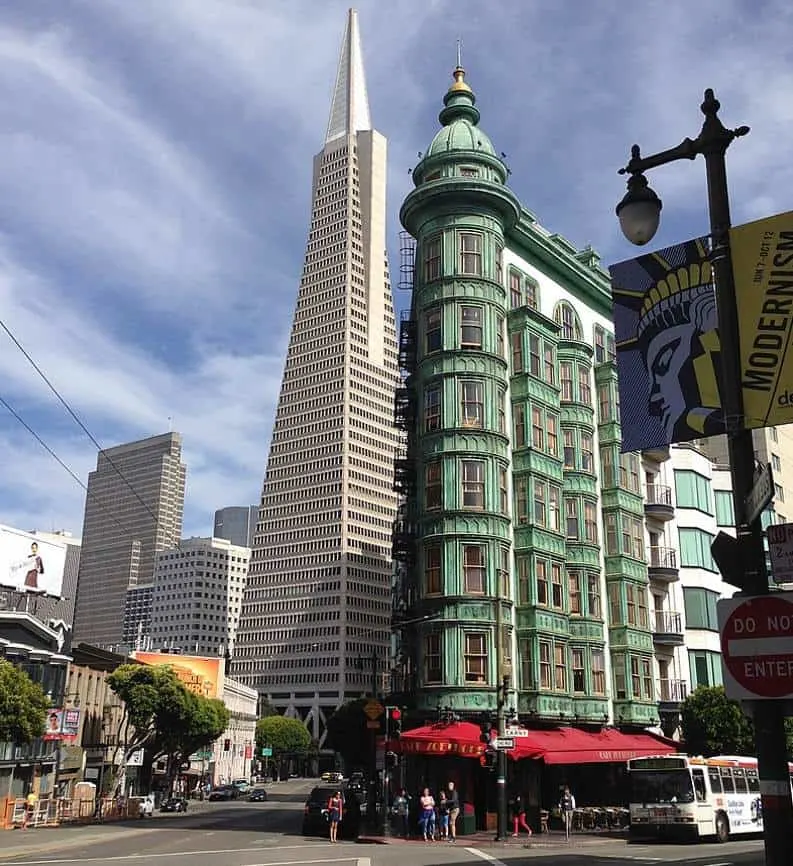
9. San Francisco–Oakland Bay Bridge
The San Francisco–Oakland Bay Bridge is another bridge spanning the San Francisco Bay, and even though it’s not as famous as the Golden Gate Bridge, it’s equally impressive.
It was built in just 3 years between 1933 and 1936 and has become one of the busiest bridges in the United States, carrying on average 260,000 vehicles a day.
The bridge is also referred to as the “Bay Bridge” and originally carried road traffic on its upper deck and rail traffic on its lower deck.
This has been modified and now both decks carry road traffic.
A serious renovation project was completed between 2002 and 2013 at a cost of over USD 6.5 billion!
The bridge is especially amazing to check out at night because of the so-called “Bay Lights.” This light sculpture consists of 25,000 LED lights and illuminates the bridge magnificently.
Official website: San Francisco-Oakland Bay Bridge

10. Conservatory of Flowers
The Conservatory of Flowers is a greenhouse and botanical garden located in the immense Golden Gate Park in San Francisco.
The park covers a total area of 1,017 acres (412 hectares) and the building was completed in 1879, making it the oldest structure located within the park.
It houses a large collection of rare and exotic plants and is the oldest remaining municipal wooden conservatory in the country.
Because of its remarkable history, it has been listed on the National Register of Historic Places and has been designated as both a California and San Francisco Historical Landmark.
Official website: Conservatory of Flowers
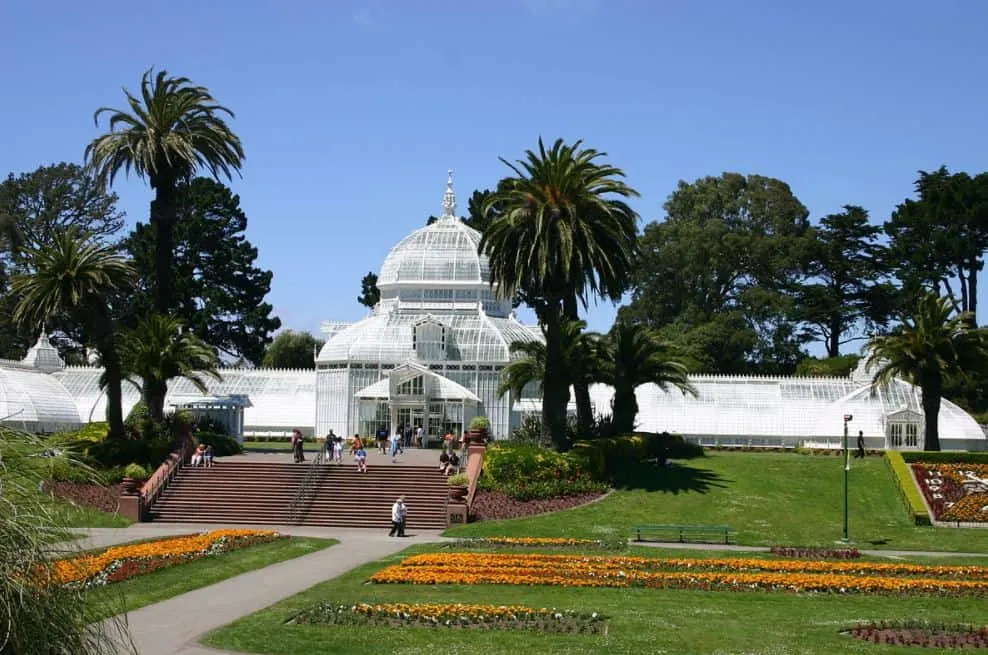
11. Ghirardelli Square
The Ghirardelli Square is one of the most fascinating squares in San Francisco and a must-visit location to hang out during your stay in the city.
It’s located in the Marina District of the city and features multiple cafes, restaurants, and a 5-star hotel, as well as a wide variety of shops.
The square was named after Domenico Ghirardelli, a man who purchased the entire city block in 1893 to establish the headquarters of the Ghirardelli Chocolate Company.
Part of the square has been listed in the National Register of Historic Places to save it from being occupied by apartment buildings.
Some of the restaurants and shops at the square date back to the 1960s, the time that the area was transformed into an amazing public space in the city.
Official website: Ghirardelli Square

12. San Francisco City Hall
San Francisco City Hall is the seat of government of the city and the building was constructed between 1913 and 1916.
It was designed in the magnificent Beaux-Arts style and can easily be described as the epitome of the “City Beautiful movement” or “American Renaissance” in San Francisco.
One of the most remarkable features of the structure is its magnificent dome, which is exactly 42 feet (12.8 meters) taller than perhaps the most famous dome in the United States, that of the Capitol Building in Washington D.C.
The current building replaced the original City Hall that was destroyed by the 1906 Earthquake.
As one of the most iconic buildings in San Francisco, it served its purpose as a film location multiple times as well.
The final scene of “Indiana Jones and Raiders of the Lost Ark” was filmed here, and an important scene from the famous cop movie “Dirty Harry” was filmed in the mayor’s office itself, quite amazing!
Official website: SF City Hall
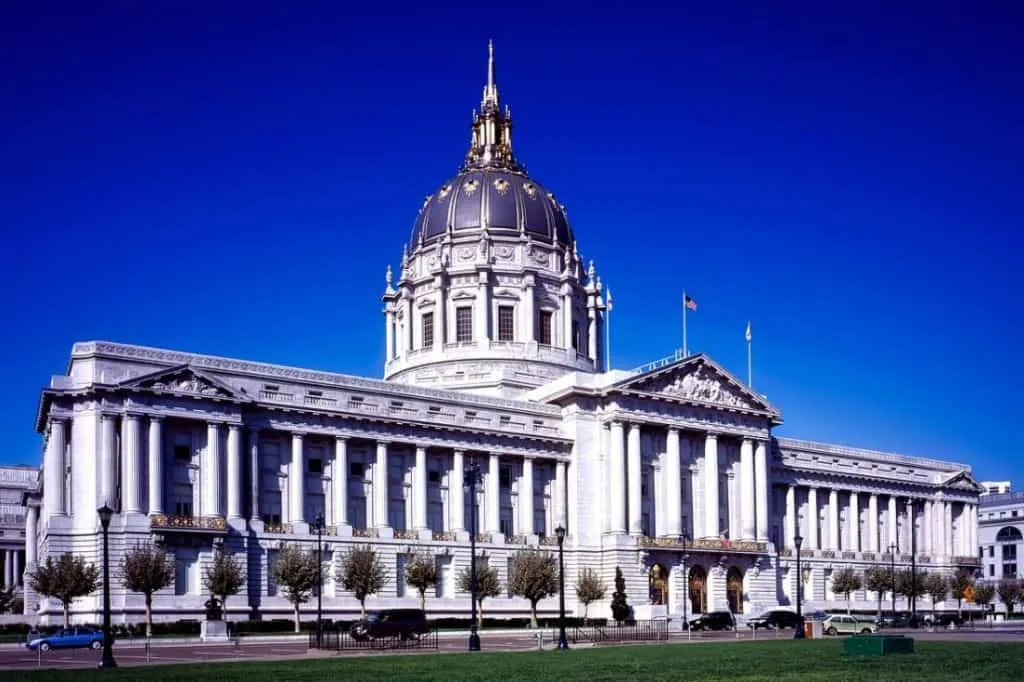
13. Grace Cathedral
Grace Cathedral is an Episcopal cathedral and the main church of the Episcopal Diocese of California.
It’s located in the Nob Hill neighborhood of the city, an area known for its numerous luxury hotels and historic buildings.
This famous church is another building that replaced a building that was destroyed during the large earthquake in the early 20th century.
Funds were raised for the construction of a new building and after multiple decades it was finally built, a project that took 30 years to complete between 1934 and 1964.
Apart from various works of art and amazing stained glass windows, the ultimate highlight inside the church is a replica of the doors of the Florence Baptistery created by Lorenzo Ghiberti’s
These doors are referred to as the “Ghiberti Doors” and were once referred to as the “Gates of Paradise” by famous Renaissance artist Michelangelo.
Official website: Grace Cathedral
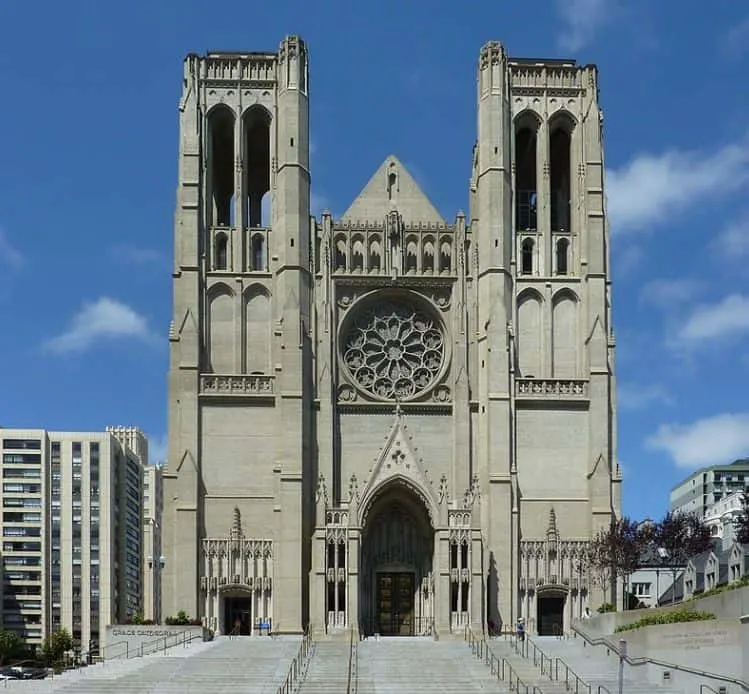
14. War Memorial Opera House
The War Memorial Opera House is a magnificent opera house located at the back of the San Francisco City Hall.
It’s a main component of the San Francisco War Memorial and Performing Arts Center and has been the main venue for opera in the city since its opening in 1932.
The opera house has a capacity of 3,126 seats and was partially rebuilt in the year 1993.
The original building was designed by Arthur Brown Jr., the man who also designed the new City Hall building.
The building is the permanent home of the “San Francisco Opera” and has been since the opening night of the building in 1932.
Official website: SF Opera

15. Salesforce Tower
The Salesforce Tower was originally known as the “Transbay Tower” and overtook the Transamerica Pyramid as the tallest skyscraper in San Francisco in 2018.
It stands 1,070 feet (326 meters) tall and is located in the South of Market district of downtown San Francisco.
The skyscraper is the centerpiece of the San Francisco Transbay redevelopment plan. It was constructed between 2013 and 2018 at a total cost of USD 1.1 billion.
This fascinating skyscraper is an amazing new addition to the city’s skyline and one of the amazing new Landmarks in San Francisco!
Even though the 61st floor, known as the “Ohana Floor,” features an observation deck, this is only reserved for employees of the Salesforce company.
The most fascinating feature of this skyscraper is a 9-story light sculpture located at the top of the tower called “Day for Night.”
This displays abstract videos that were shot during the day in San Francisco every night, quite an amazing feature that was added in 2018 of the already amazing SF skyline.
Official website: Salesforce Tower
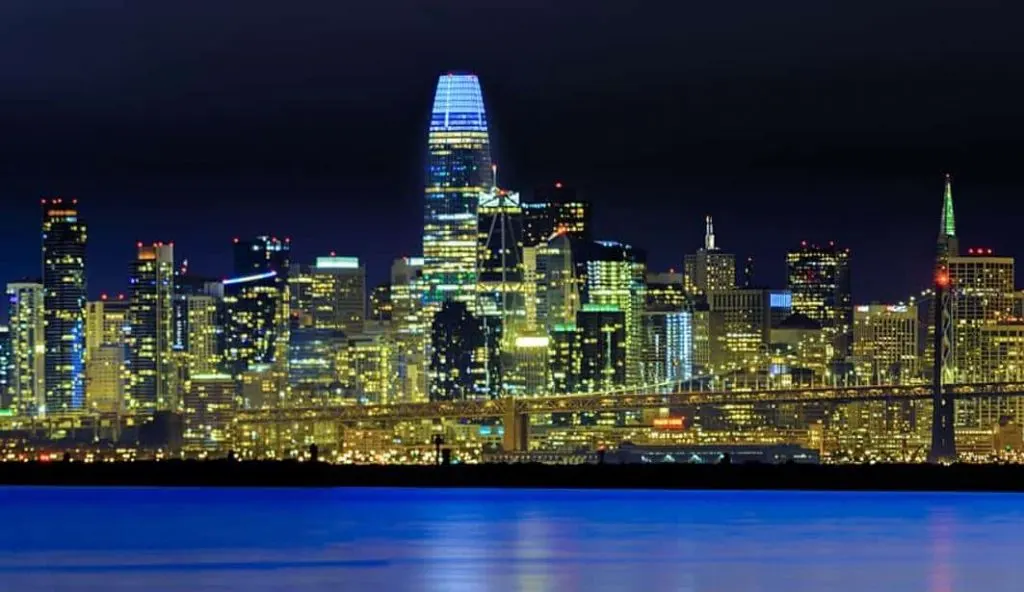
16. San Francisco Museum of Modern Art
The first museum dedicated to the modern art of the 20th and 21st centuries on the west coast of the United States is located in San Francisco.
The San Francisco Museum of Modern Art (SFMOMA) was founded in 1935 and originally housed at the War Memorial Building, a structure now dedicated to performing arts.
The structure that the collection of the museum is housed at today was completed in 1995 and is located in the SoMa (South of Market) district of the city.
The structure was seriously expanded in 2016 which nearly doubled the exhibit space to over 170,000 square feet (16,000 square meters).
Highlights of the museum include “A Set of Six Self-Portraits” by Andy Warhol, “Intermission” by Edward Hopper, and “Violin and Candlestick” by Georges Braque.
The collection features over 33,000 items including paintings, sculptures, photographs, architectural features, design, and media arts.
Official website: SFMOMA
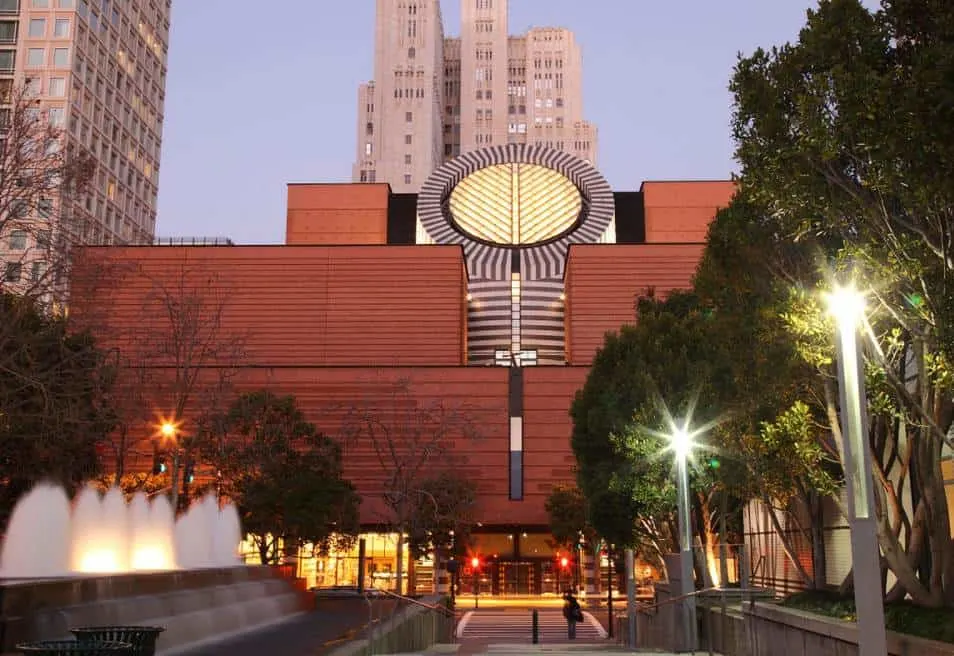
17. PIER 39
Pier 39 is both a tourist attraction and a shopping center that was built on a pier in the northeastern part of the city.
Apart from numerous retailers and restaurants, it also offers multiple entertainment facilities such as a video arcade and 3D rides.
The most popular attraction at Pier 39 is the California sea lions that love to hang out on parts of the pier. They started coming here in September 1989 and haven’t left since.
Before they started using the pier as their permanent hangout they did so at Seal Rock, a small rock formation in Western San Francisco.
Why they suddenly came here remains a mystery, but it’s assumed that they simply feel much safer in this location.
They surely don’t mind the hoards of spectators staring at them and many barely move an inch during the day, quite a fascinating scene.
Official website: PIER 39
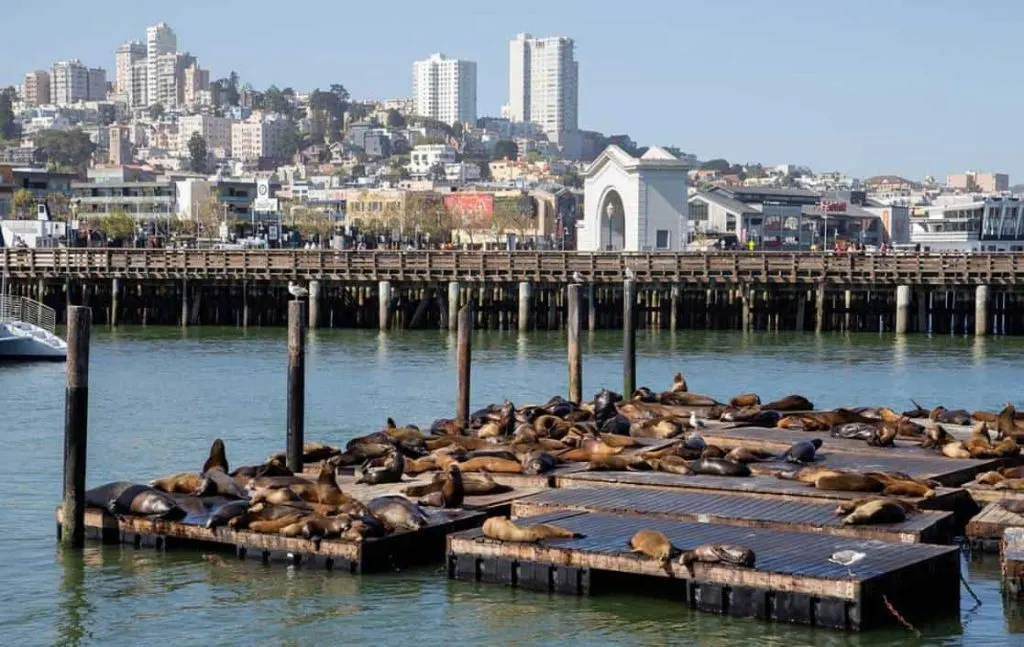
18. Lombard Street
This street has sometimes been referred to as the “crookedest street in the world“, and when you take a good look at it you can instantly see why.
Lombard Street runs from east to west and even though it’s a major thoroughfare in the city which connects the Presidio east to the Embarcadero, it’s world-famous for one particular section.
This part of the street is extremely steep and features 8 hairpin turns, something that has turned it into a major tourist attraction in the city.
On busy summer days, the number of people ascending the street can reach up to 17,000 and an estimated 2 million visitors make the trip to the top every year.
Even though the straight line of this section of the street is only 412.5 feet (125.7 meters) long, you’ll have to walk 600 feet (180 meters) to reach the top on the red pavement.
One final interesting fact about Lombard Street is that it was named after a street with the same name in Philadelphia in the 19th century.
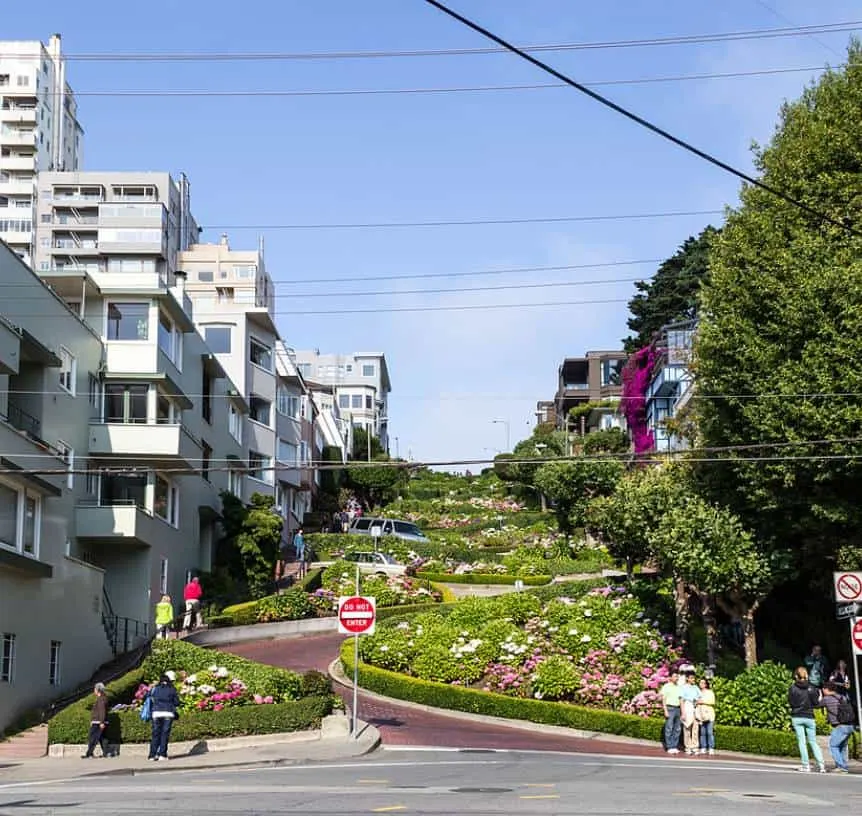
19. Japanese Tea Garden
A popular attraction inside the borders of the immense Golden Gate Park in the northwestern part of the city is a place known to bring peace and tranquility to visitors.
The Japanese-style garden was originally built for the 1894 World Fair in the city but has been changed quite a bit since then.
Regardless, it’s the oldest garden of its kind in the United States and many features dating back to the late 19th century are still present today.
As expected, the gardens are designed in the typical Japanese style featuring numerous ponds and distinctively organized trees and shrubs.
It covers an area of about 5 acres (2 hectares) inside the park and features numerous sculptures related to the Buddhist and Shinto religions.
Even though the tea house was part of the original garden, it has been rebuilt a few times and can easily be considered to be the best place in the city to enjoy a nice cup of green tea.
Official website: Japanese Tea Garden SF
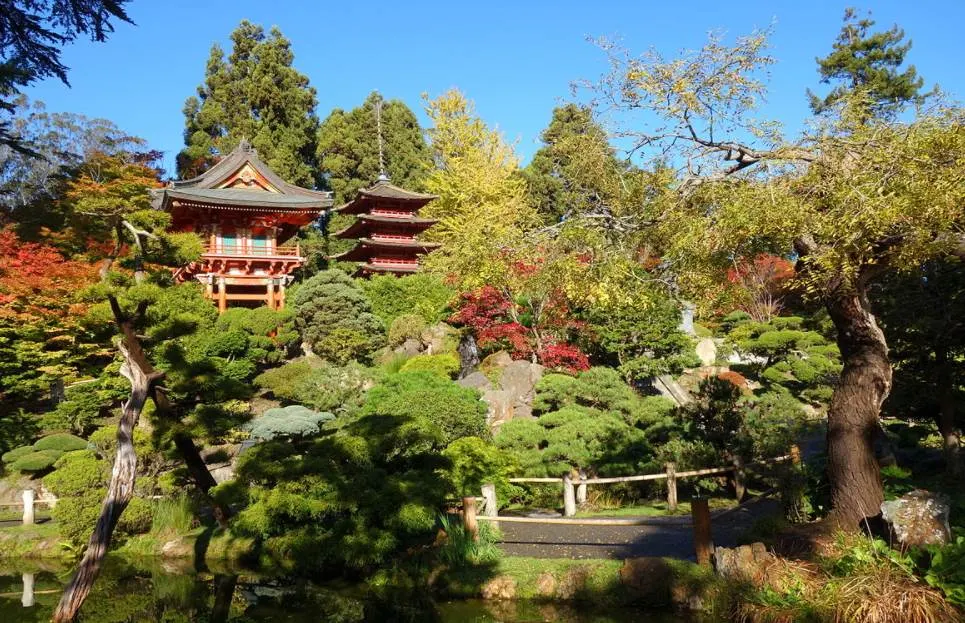
20. Union Square
Even though the name Union Square refers to a famous plaza in Downtown San Francisco, it’s also used to describe a much larger area surrounding it.
The area is described as the commercial hub of the city and features numerous retailers and boutiques, but had quite a different purpose originally.
The name of the square refers to rallies held here by Thomas Starr King (1824-1864) during the American Civil War.
The man was strongly in favor of the Union and is credited with saving California from becoming a separate republic, quite an achievement.
The center of the square is decorated with the “Dewey Monument,” erected in honor of Admiral George Dewey to commemorate his victory in the Battle of Manila Bay in 1898 during the Spanish-American War.
The square covers an area of 2.6 acres (1.1 hectares) and is one of the most popular public spaces in the city.

21. Exploratorium
If you’re somewhat of a geek, then this place will feel like heaven to you. If not, you’ll still have a fun and educational time at the Exploratorium.
This museum is dedicated to science and technology and is very much focused on visitors participating in the various exhibits.
Who else would have found such an interesting museum other than a scientist, right?
That’s exactly what happened as the museum was established in 1969 by physicist and professor Frank Oppenheimer (1912-1985).
The original location of the museum was the amazing Palace of Fine Arts, but it has been moved to its new location at Piers 15 and 17 of SF’s Embarcadero.
The museum features 1,000 participatory exhibits of which over 600 are available at any time. This means a lot of fun, excitement, and learning a lot of new things during your visit.
Official website: Exploratorium

22. Painted Ladies
The city is home to one of the most iconic rows of houses in the United States known as the “Painted Ladies.”
Even though this is the actual name given to this row of repainted Victorian and Edwardian houses, this is the common name to describe these types of buildings in general.
Even though these types of houses only emerged for the first time in the 1960s, the term was only first used in a 1978 novel written by Elizabeth Pomada and Michael Larsen called “Painted Ladies: San Francisco’s Resplendent Victorians.”
Today, multiple cities in the United States feature Painted Ladies, but the iconic row in San Francisco with the city’s skyline in the background is the most famous.
Want to enjoy a relaxing moment with some of the greatest views in the city?
Then you need to head over to Alamo Square Park, a small park located just a few blocks west of San Francisco City Hall.

23. Asian Art Museum
The city is home to one of the largest museums dedicated to Asian Art in the world. The SF Asian Art Museum has a collection size of over 18,000 exhibits, some world treasures that are over 6,000 years old.
The museum was established in 1966 and up until 2003, it was located next to the de Young Museum in a complex within the Golden Gate Park.
The rapid growth of the collection size resulted in a move to the former San Francisco Library Building which is located right across the city’s Civic Center.
The interior of the building was completely redesigned by renowned Italian architect Gae Aulenti (1927-2012), a woman who was involved in multiple similar projects in Paris and who has a popular modern square named after her in Milan, Italy.
The museum now features an exhibit space of 185,000 square feet (17,200 square meters), an increase of 75% compared to its former location.
Want to see Samurai armor or ancient Buddha statues from various Asian countries? Then this is the place to visit.
Official website: Asian Art

24. Walt Disney Family Museum
If you’re a Disney fan, then you’ll surely enjoy this gem of a museum. As the name of the Walt Disney Family Museum implies, it features exhibits related to the life of Disney’s founder, Walt Disney (1901-1966).
The museum is located in the northern part of the huge Presidio of San Francisco Park and is housed in 3 historic buildings that were renovated for this purpose.
It’s also a non-profit museum that was established and is operated by the Walt Disney Family Foundation. This also means that it has no connection to the Walt Disney Company even though it was founded by Walt Disney’s heirs.
What you’ll find in the museum are exhibits related to the life of Walt Disney himself and items dating back to the early period of animation films.
One of the most amazing items is the first-ever drawing of Mickey and Minnie Mouse, quite something because just about everybody in the world knows these characters by now.
Official website: Walt Disney Family Museum
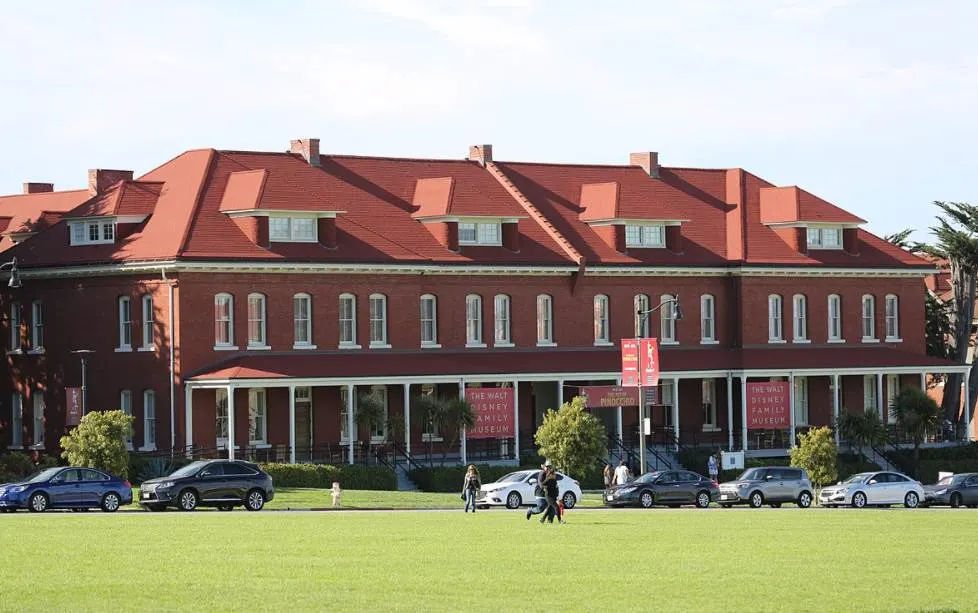
25. Legion of Honor
The Legion of Honor is the name used to describe both a museum of fine arts in San Francisco and the amazing historic building that the collection is housed in.
What’s remarkable about this structure is that it’s a replica of the French Pavilion at the 1915 Panama–Pacific International Exposition. This building was, in turn, a 75%-scale replica of the “Palais de la Légion d’Honneur,” a historic building in Paris.
The building was originally known as the “California Palace of the Legion of Honor” and was built between 1921 and 1924.
It’s situated in an elevated location of Lincoln Park in the utmost northwestern corner of the city, just south of Lands Ends Lookout.
The collection spans a history of 6,000 years of ancient and European art. The most notable collection inside the museum are works by famous French sculptor Auguste Rodin, including a version of his world-famous “The Thinker” located in the building’s Court of Honor.
The collection of paintings isn’t too shabby either with works of renowned artists such as El Greco, Titian, Rubens, Rembrandt, Boucher, Degas, Monet, and van Gogh.
Official website: Legion of Honor
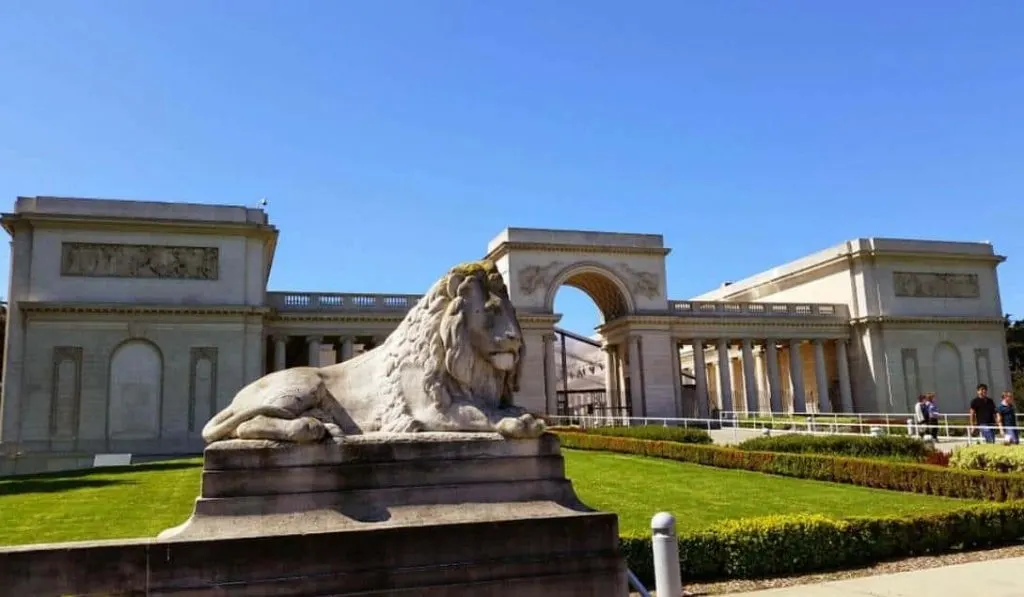
26. California Academy of Sciences
The city is home to one of the largest natural history museums in the world known as the California Academy of Sciences.
This museum is located in the eastern part of the immense Golden Gate Park and features a collection of over 46 million specimens, quite incredible indeed.
The museum started as a research facility in 1853 and still serves this purpose today.
The building of the museum before 2005 was torn down and replaced with an enormous structure designed by renowned Italian architect Renzo Piano. He is best known for his work on the Centre Georges Pompidou, the peculiar structure in the heart of Paris.
His work on this building has been praised globally for its remarkable environmentally friendly design. Especially the green roof covering an area of 2.5 acres (1 hectare) is quite amazing.
Official website: Cal Academy
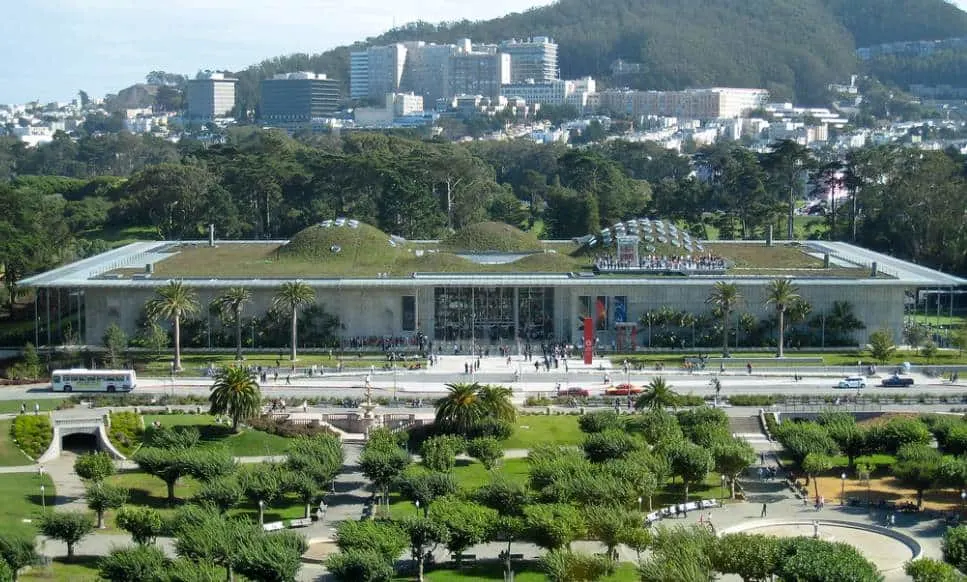
27. Oracle Park
The San Francisco Giants are a Major League Baseball team that play their home games in one of the most fascinating baseball stadiums in the world.
Oracle Park is located right next to San Francisco Bay in the South Beach district of the city. The section in which the stadium was built is known as “McCovey Cove,” referring to former Giants player Willie McCovey (1938-2018).
It was opened in the year 2000 and has gone by a couple of names during its relatively short history, including Pacific Bell Park, SBC Park, and AT&T Park. It got its current name in 2019 from the Oracle Company.
Even though it’s always great to visit the 41,915-seat-stadium during a game, there are also tours available. This allows you to go places where only the players and staff of the team are allowed to go normally.
Apart from baseball games, the stadium is also sometimes used for concerts, and what an amazing concert venue it is, don’t you think?
Official website: Oracle Park at MLB
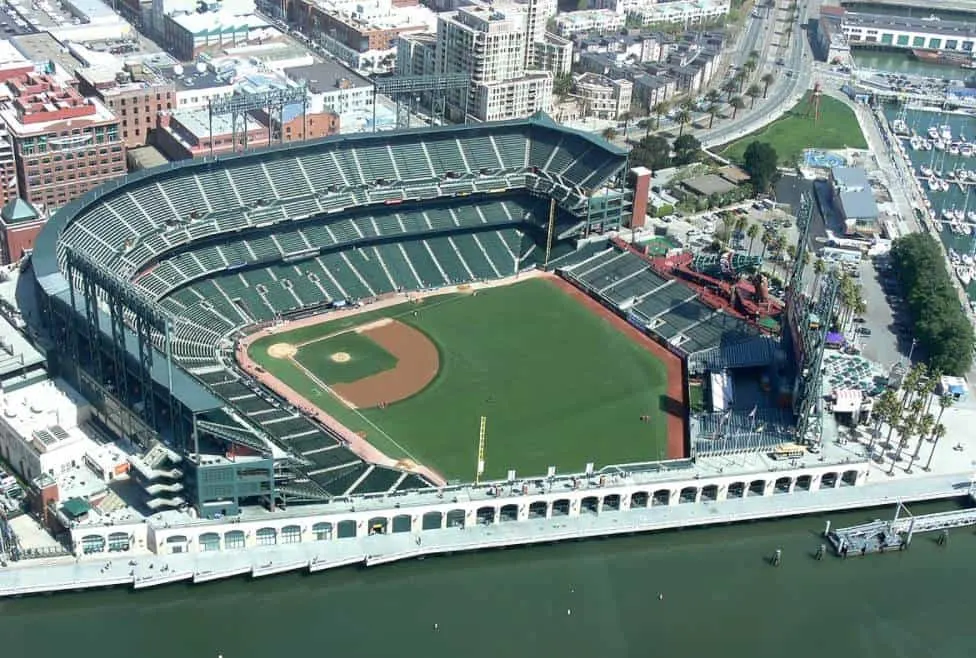
28. De Young Museum
Just a short walk north from the Botanical Garden you can find yet another fascinating museum dedicated to fine arts known as the “de Young Museum,” often referred to as simply the “de Young.”
It’s one of the so-called “Fine Arts Museums of San Francisco” of which also the Legion of Honor is part.
The museum was established in 1895 and is named after local businessman and journalist Michael Henry de Young (1849-1925). The museum was established because of an international fair that was held in the city called the California Midwinter International Exposition of 1894.
The original building was severely damaged during the 1989 Prieta Loma Earthquake and replaced with the current building in 2005.
The main collection of the museum is American Art from the 17th to the 21st centuries. It also features works of African Art, Oceanic Art, and even a European collection with paintings from artists such as Salvador Dalí.
With over 1.5 million yearly visitors it’s also one of the most popular museums in the city.
Official website: de Young
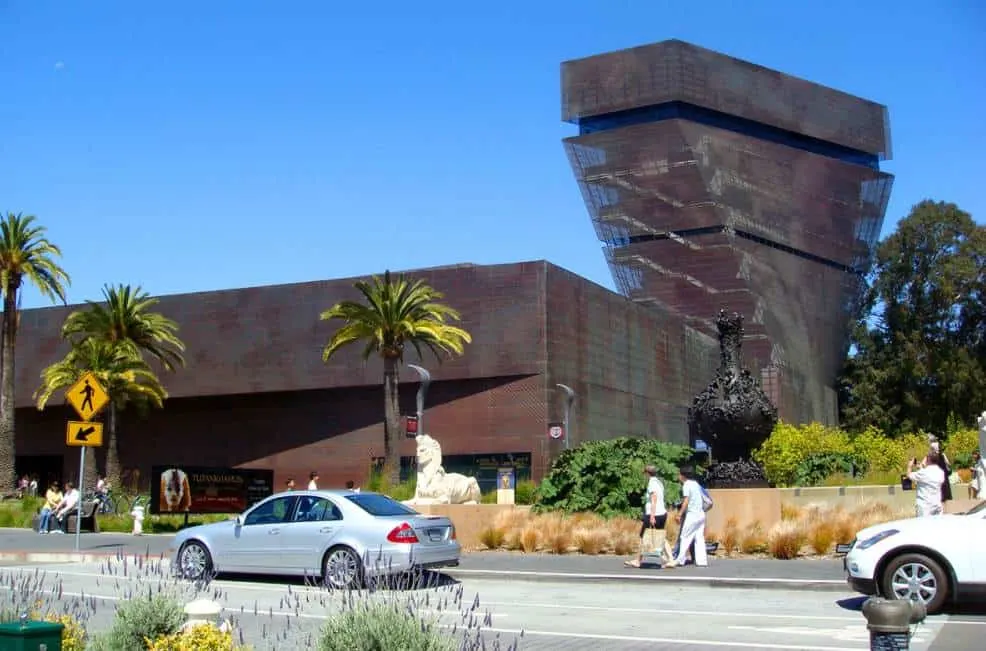
29. Sutro Baths
Even though hiking in the area of Lands End next to the Legion of Honor mostly features great ocean views, there’s also a historic ruin located here of a remarkable structure.
The Sutro Bath was a privately owned swimming pool complex that was built and operated by former SF mayor Adolph Sutro (1830-1898).
The complex was completed in 1894 and completely burned down in 1966. Today, only the ruins of the Sutro Baths are visible.
The baths were huge and featured 5 saltwater and 1 freshwater pool. These had a combined length of 499.5 feet (152.2 meters) and a width of 254.1 feet (77.4 meters), good for a capacity of 1.805 million gallons (6,830 cubic meters) of water.
Interesting note, the area of the ruins is known as the “Sutro Historic District.”
Official website: Sutro Baths

30. Aquarium of the Bay
RIght near the edge of the most entertaining pier in SF at the Embarcadero, PIER 39, you can find the “Aquarium of the Bay.”
The building of the aquarium covers an area of 65,000 square feet (6,000 square meters) and is mainly focused on marine animals living in the nearby San Francisco Bay and surrounding areas.
The aquarium is an affiliate of the renowned Smithsonian Institution and originally opened its doors as the “UnderWater World” in 1996.
The aquarium has a total capacity of 770,000 gallons (2,900,000 liters) and had a huge price tag of USD 38 million to build back in the 1990s.
The most amazing attraction inside the aquarium is a tunnel that allows you to walk among sharks, batfish, rockfish, and other fascinating marine creatures.
This alone makes visiting this attraction worthwhile, especially on Tuesday and Thursday mornings when volunteer divers clean the tank and hand-feed some of the fish.
Official website: Aquarium at the Bay
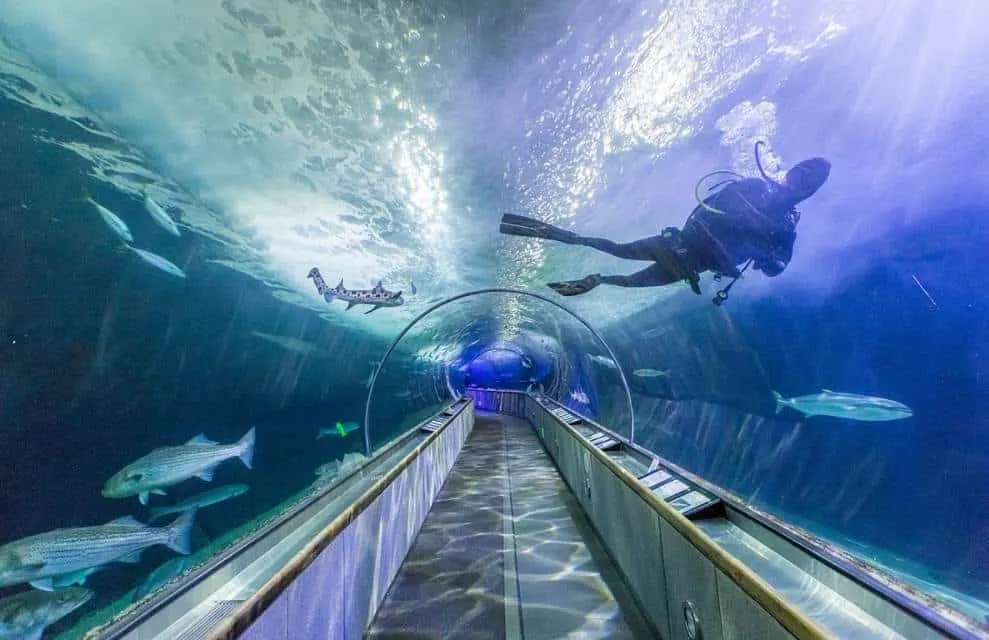
31. Cable Car Museum
If you’re interested to learn about the history of fascinating cable cars that have become an icon of the city, then the Cable Car Museum is the place to visit.
The museum is free to enter is located in the Nob Hill neighborhood of the city just west of Chinatown.
The SF Cable Car system is the last of its kind that is operational in the world, and you can have a closer look at how it operates inside this museum.
The museum is located inside the Ferries and Cliff House Railway Co. building. This structure was built in 1887 and also features the actual cable car powerhouse, the system that drives the cables.
There are two historic cable cars on display that date back to the 1870s, quite fascinating exhibits to say the least.
Official website: Cable Car Museum
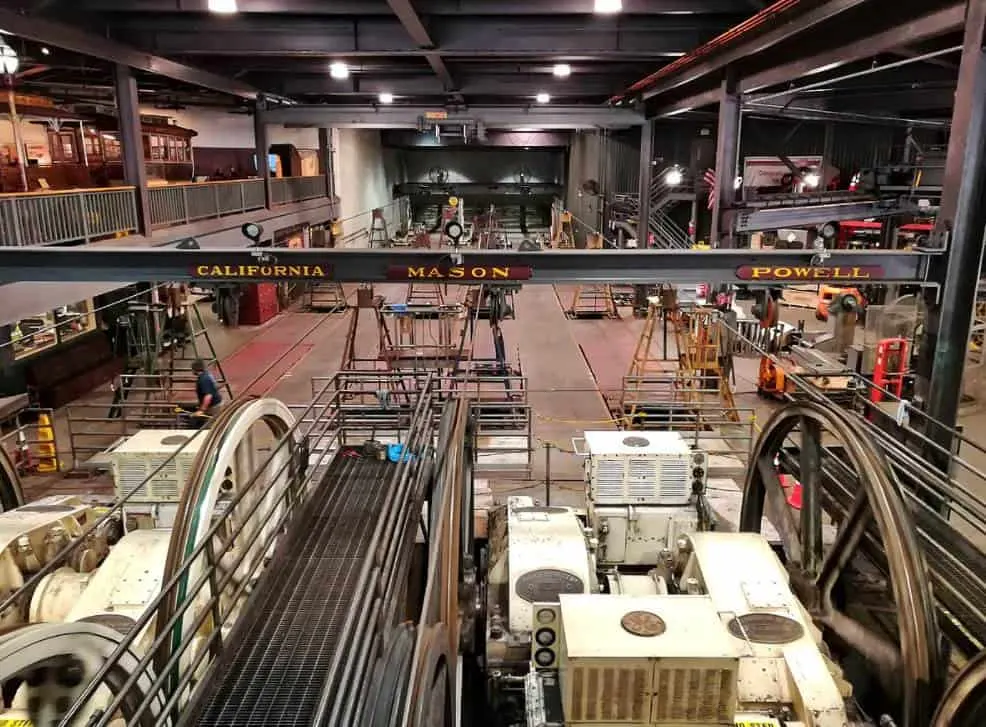
32. Mission Dolores Park
In the western part of Mission District, you can find a great city park to enjoy a picnic and simply relax, right in the heart of the city.
Mission Dolores Park is mostly referred to as simply the “Dolores Park.” It covers an area of 15.94 acres (6.45 hectares) and was established in 1906.
The Mission neighborhood is one of the best places in the city to hang out as well and has been called “the coolest neighborhood in the world” in 2016.
The park features multiple sports facilities such as tennis courts, a basketball court, a soccer pitch, and a children’s playground. This makes it a popular place among locals.
The vicinity of Downtown San Francisco also means that this park provides excellent views of the most famous buildings in San Francisco.
Official website: Mission Dolores Park
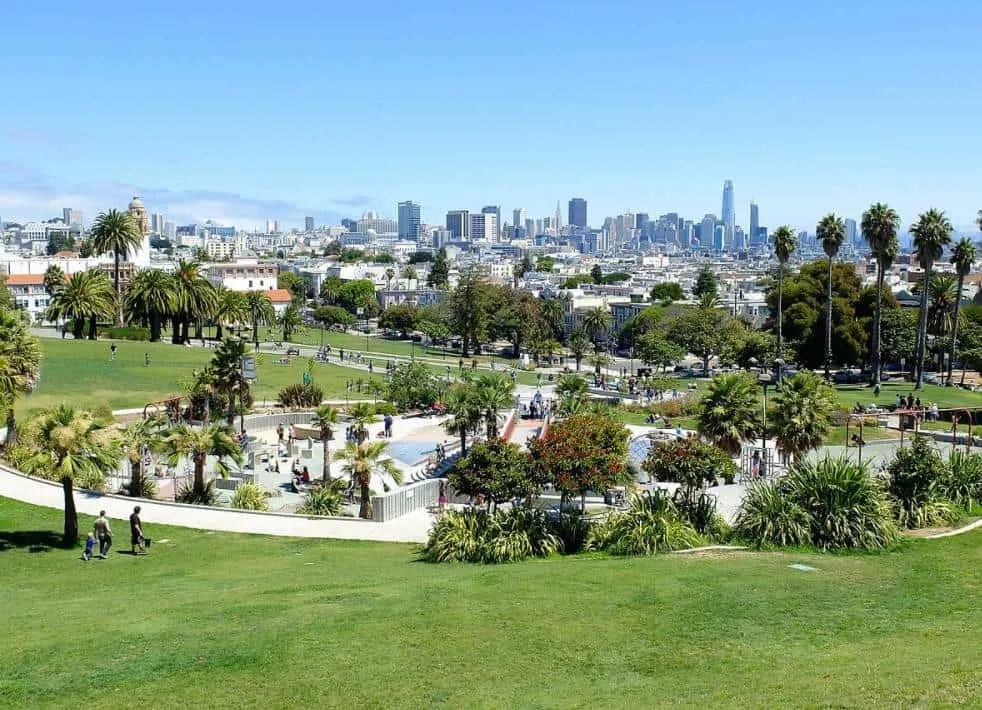
33. 16th Avenue Tiled Steps
Just like the name of the attractions suggests, 16th Avenue in the Golden Gate Heights neighborhood of San Francisco features a huge staircase featuring 163 steps.
A community project founded by locals in 2003 has turned this staircase into an amazing work of art. The idea was to create a sea-to-stars-themed mosaic.
Two artists were hired to create 163 mosaic panels and the result is quite amazing.
The work was completed in 2005 and the official opening ceremony of the stairway happened on August 27 of that year.
The people were joined by the Mayor of Caltagirone, Italy, a town on the island of Sicily, home of its sister stairway named the “Scala Steps,” a famous landmark dating back to the year 1606.
Just remember, Every August 27 is “16th Avenue Tiled Steps Day” in the city”
Official website: 16th Avenue Tiled Steps
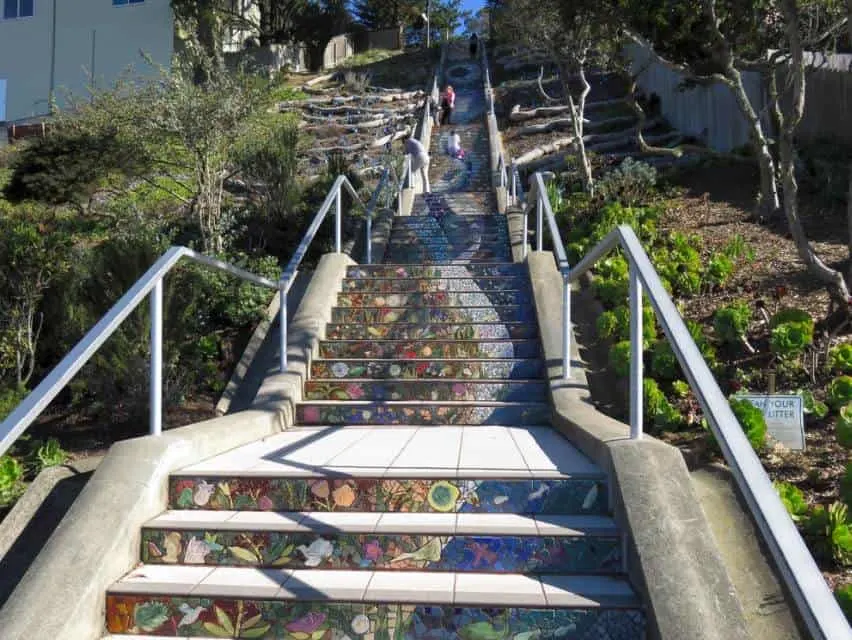
34. Wave Organ
In the utmost northern tip of San Francisco, not too far away from Alcatraz Island, a remarkable sculpture has been built known as the Wave Organ.
This sculpture produces acoustic sounds by interacting with the waves of San Francisco Bay. Different sounds are produced at different stations that are part of this fascinating artwork.
The sculpture was built in this location since it was conceived in 1986 and was developed by an artist engaged by the Exploratorium named Peter Richards.
It was built using stones from the former Laurel Hill Cemetery and consists of 25 different PVC pipe organs that produce organic sounds.
You can access the location of the sculpture in Marina Green Park, an iconic grassy area in the northern part of the city.
Official website: Wave Organ
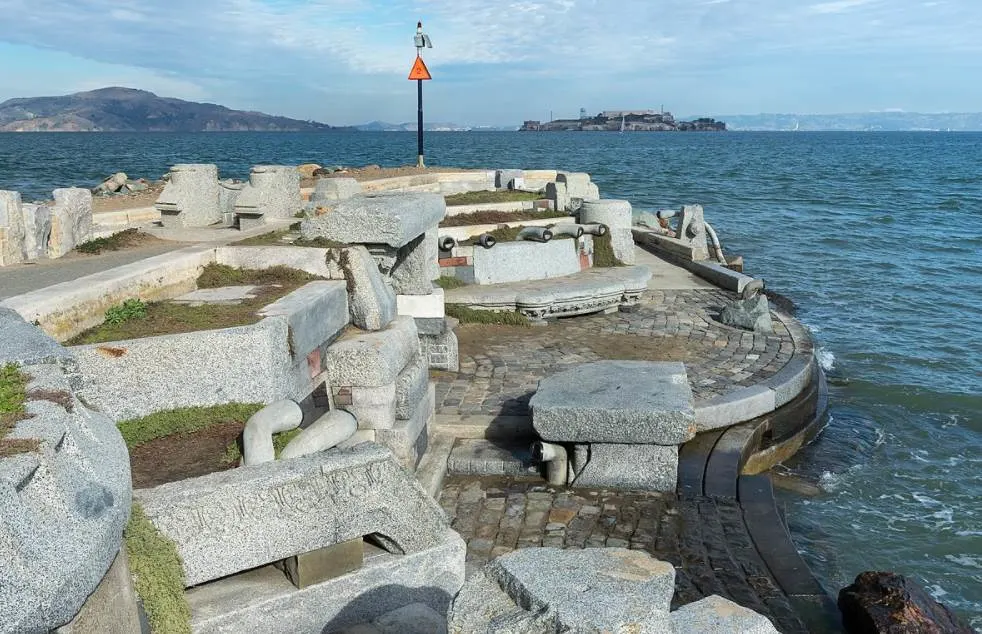
35. Mount Davidson Cross
Even though Mount Davidson is the highest natural point in San Francisco, it’s only 3 feet (1 meter) taller than the summits of Twin Peaks as it stands 928 feet (283 meters) tall.
The hill is located just south of the two major peaks in the center of the city and just west of the Diamond Heights and Glen Park neighborhoods of the city.
The hill is a popular spot to hike and is topped with an enormous concrete cross that stands 103 feet (41.4 meters) tall right on its highest point.
This cross is illuminated on Easter and the location of a yearly prayer, as well as the yearly commemoration of the Armenian genocide. This was a mass murder that caused the death of an estimated 1 million people between 1915 and 1917 in the Ottoman Empire.
Part of the hill is part of Mount Davidson Park, an amazing place to hike while checking out the great views from the natural roof of the city.
Official website: Mount Davidson

36. Madame Tussauds
If you’re not familiar with Madame Tussauds, then the short description is that it’s the most famous wax statue museum in the world.
It features wax replicas of the most famous people on the planet, allowing you to get a close-up look at popular celebrities and important figures in world history.
The museum has branches all over the world, including (but not limited to) London, New York, Sydney, Bangkok, and Berlin.
The history of the museum is interesting as well because it was founded by Marie Tussaud (1761-1850), originally a court artist just before the French Revolution.
She was offered a way to avoid being guillotined by creating death masks of the royals that ended up with their heads chopped off. She eventually moved to London and turned her talent into an attraction.
The SF branch of the museum is located at Fisherman’s Wharf and features wax statues of Beyoncé, Alfred Hitchock, and Jimi Hendrix, to name just a few.
Official website: Madame Tussauds SF
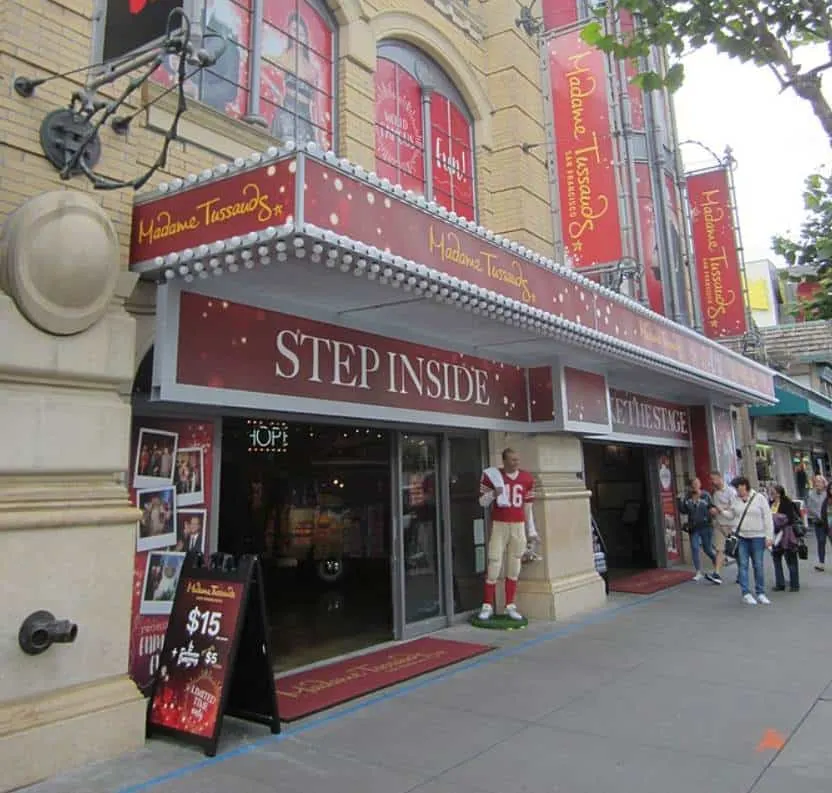
37. Yerba Buena Gardens
One of the best places to relax in Downtown San Francisco is a public park known as the “Yerba Buena Gardens.”
This park is located between Third and Fourth, and Mission and Folsom Streets, and occupies an area of about 2 city blocks.
It’s one of the newer city parks in SF as well because the first section only opened on October 11, 1993, and expanded again in 1998 to include the section between Howard and Folsom Streets.
The park was named after Yerba Buena, the name of the original settlement that was still Mexican territory in Alta California before 1846. After being claimed by the United States, the city was renamed, San Francisco.
This original settlement was in turn named after the yerba buena plant, a type of herb that grew abundantly in the region. Yerba Buena also translates from Spanish to “good herb.”
Official website: Yerba Buena Gardens
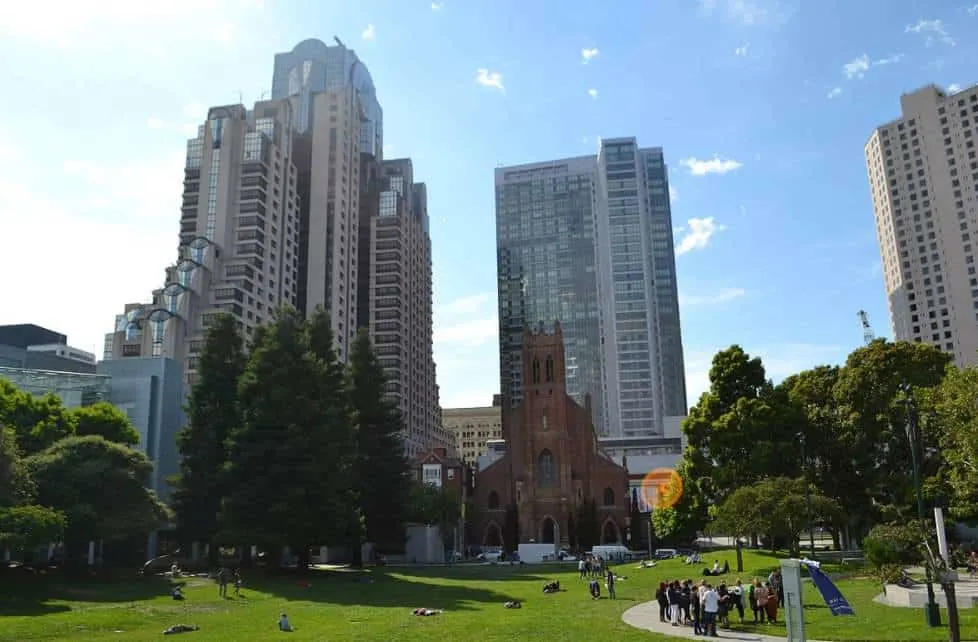
38. Point Bonita Lighthouse
It’s hard to deny that one of the most fascinating buildings in San Francisco is the Point Bonita Lighthouse, an amazing lighthouse constructed on a rocky outcrop of the San Francisco Bay.
To reach “Point Bonita,” you’ll need to cross the Golden Gate Bridge and pass the Marin Headlands.
This rock forms the utmost southwestern tip of Marin County and is considered the entrance of the San Francisco Bay on the northern side.
The original lighthouse was built in 1855 but was located at an elevation of 306 feet (93 meters). This was too high so it was replaced by a lighthouse on the current location in 1877 situated at an elevation of just 124 feet (38 meters) above sea level.
The lighthouse could originally be reached by a trail but erosion has made this trail crumble into the ocean below. The original wooden walkway to the lighthouse was replaced by a suspension bridge in 1954, which is still the way to access the historic structure today.
Important note: the lighthouse can only be accessed by the general public between 12:30 and 3:30 p.m. on Sundays and Mondays.
Official website: Point Bonita Lighthouse

39. Mission Dolores
While the point Bonita Lighthouse is a fascinating historic structure, there’s a much older one dating back to the late 18th century.
The original religious structure on the site was founded on October 9, 1776, and was built in what is now the Mission District of the city.
This relatively small structure is known as the “Mission San Francisco de Asís” (1181-1226) and was named after St. Francis of Assisi, the founder of the Franciscan Order.
The name “Mission Dolores” is also sometimes used to describe this structure and refers to a creek that was once located nearby.
The larger structure located next to the historic building is called the “Mission Dolores Basilica” and was completed in 1918. This church was designed in the California Churrigueresque architectural style, an elaborate type of Spanish Baroque.
Official website: Mission Dolores
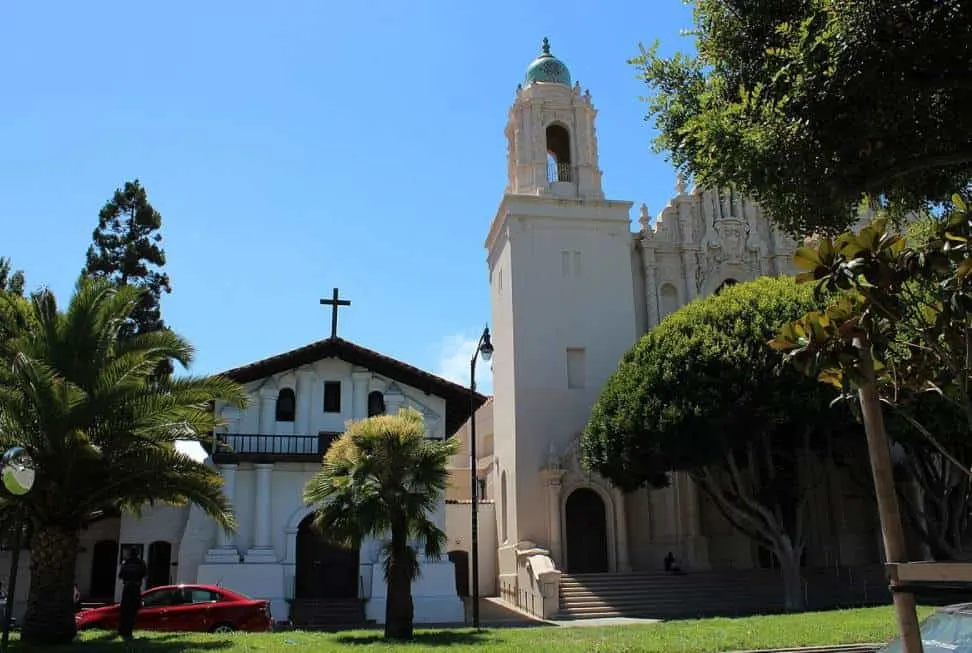
40. Musée Mécanique
If you’re somehow nostalgic about 20th-century penny arcade games, then you’ll find heaven at the “Musée Mécanique.”
The museum started with the collection of a man named Ed Zelinsky that was first exhibited in San Francisco’s “Playland,” a huge amusement park that closed its doors in 1972.
This section of the Playland was so popular that the Musée Mécanique was established to replace this section of the former seaside amusement park.
The museum features over 300 arcade games and plenty of artifacts related to them and is still managed by the son of the founder, Dan Zelinsky.
The museum allows you to play all these games and is one of the multiple entertainment facilities located at Fisherman’s Wharf in the northeastern section of the city.
Official website: Musée Mécanique
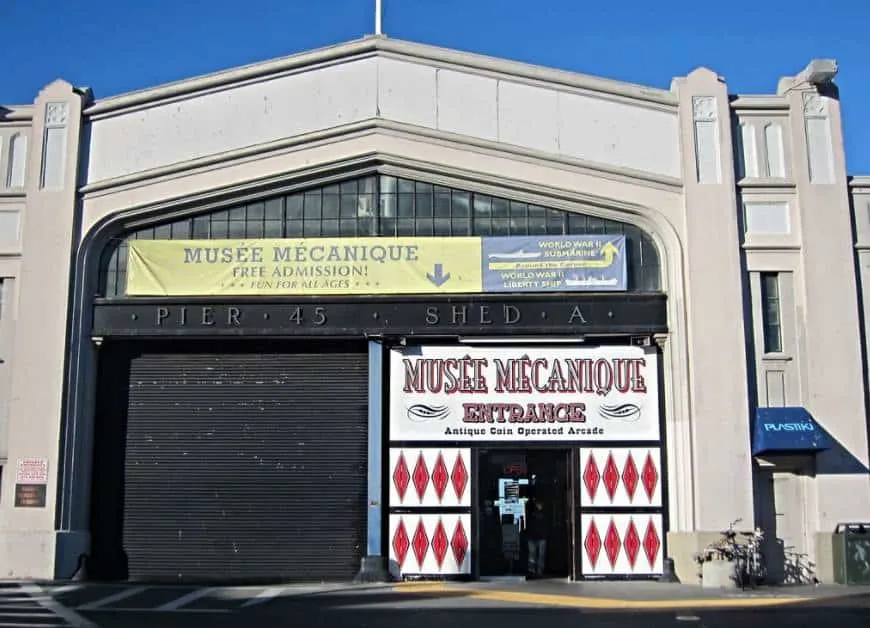
41. Yerba Buena Center for the Arts
The Yerba Buena Center for the Arts is a massive arts complex located just north of the Yerba Buena Gardens in, you guessed it right, the Yerba Buena district of the city.
The contemporary arts center is located in two landmark buildings known as the “Galleries and Forum” and the “Theater.”
The center features year-round programs such as dance performances and a wide variety of art exhibits.
Apart from being the location of events related to art, it has also been used for product launches by Apple such as iPods and the iPad.
This emphasizes the importance of the art center in the city, even though the center was only established in 1993.
Official website: YBCA

42. San Francisco Dungeon
Yet another tourist attraction located at Fisherman’s Wharf only opened its doors fairly recently in June 2014.
The San Francisco Dungeon is similar to its European counterparts in London and Amsterdam. It features historical events and thrillingly presents them using special effects, rides, and actors.
Some of the historical events revolve around the California Gold Rush, SF street gangs, the Chinatown Plague of 1900, and the Alcatraz Prison in the 1800s.
The dungeons are a franchise operated by Merlin Entertainments, a British Entertainment company that owns and manages a wide variety of attractions around the world.
This particular attraction can be described as both scary and funny, with a lot of credit given to the excellent actors.
Official website: SF Dungeon
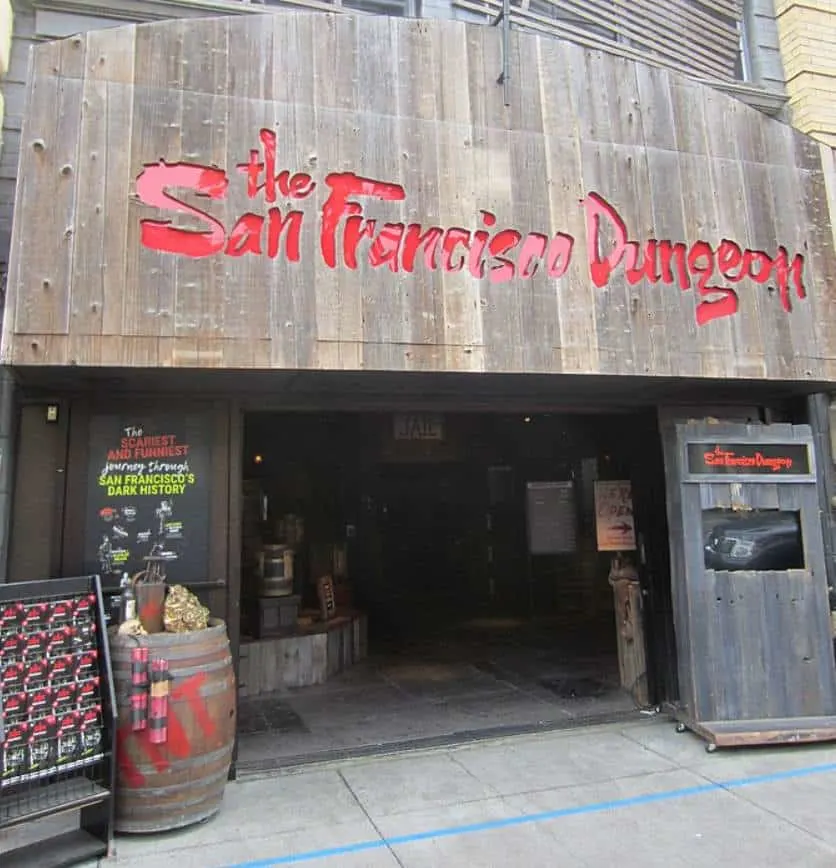
43. Washington Square
One of the first city parks to be established is located in the North Beach district of San Francisco, just west of the Coit Tower on Telegraph Hill.
Washington Square dates back to the year 1847 and is dominated by the Roman Catholic Saints Peter and Paul Church.
What used to be a potato and cattle farm before it was established as a city park is now a remarkably tranquil place in the heart of the northern part of the city.
The park is lined by several taverns and restaurants, so if you want to enjoy a nice drink or lunch you’ll find all you need in this area.
Official website: Washington Square
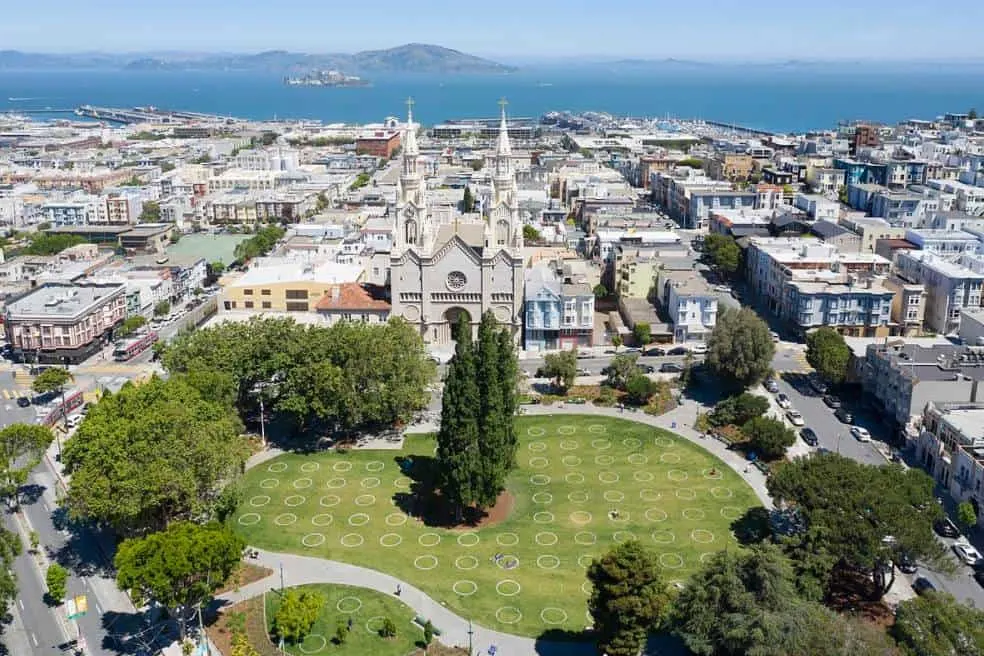
44. Aquatic Park
The Aquatic Park Historic District is located just west of Fisherman’s Wharf and has been listed on the U.S. National Register of Historic Places since 1984.
Also referred to as the Aquatic Park Cove, the park features a beach and a municipal pier that you can walk on.
It’s also home to the San Francisco Maritime Museum which was originally built as a bathhouse in 1936.
Apart from being one of the most popular places in the city to fish, the municipal pier is also a great place to walk and enjoy some fresh air just north of the bustling city.
Official website: Aquatic Park

45. Fort Mason Center
Fort Mason used to be known as the San Francisco Port of Embarkation that was used by the US Army since the year 1912.
It’s located in the Northern Marina District and has served the purpose of being a coastal defense site for over 100 years and played a major role in the Pacific Campaign during World War II.
Today, the facility has been transformed into the Fort Mason Center for Arts & Culture and is mainly used for cultural events.
The most popular event at this location is called “Off the Grid.” This event takes place between March and October and features several large food trucks that draw huge crowds to the historic site.
The immense facility features 49 historic buildings that are located on an area covering 1,200 acres (490 hectares), just west of the SF Aquatic Park.
Official website: Fort Mason Center
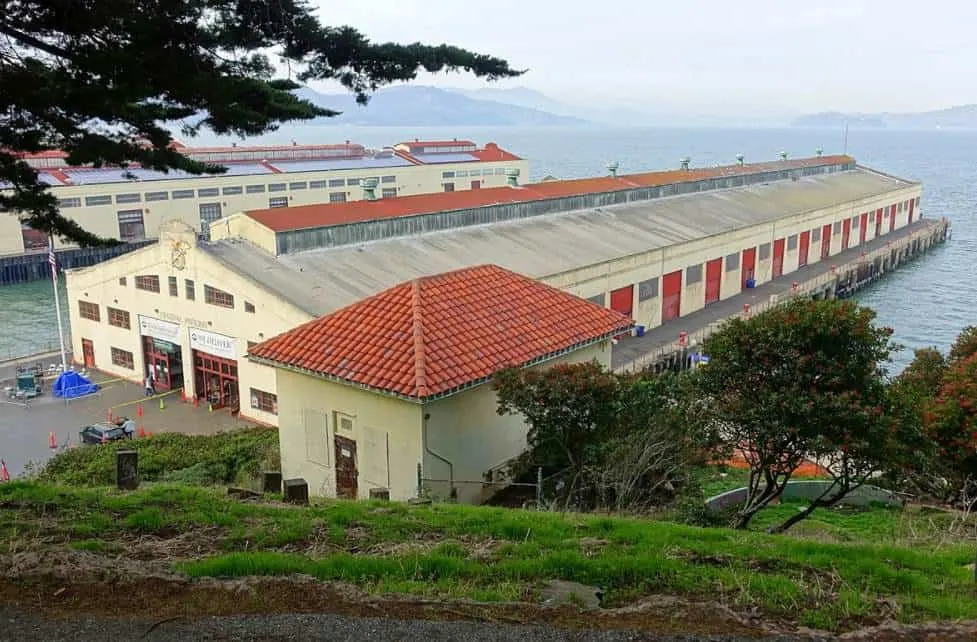
46. Haas-Lilienthal House
House museums are always interesting because they provide an intimate look into the life of their residents.
This is especially the case for this remarkable Victorian-era house that survived the 1906 Earthquake called the “Haas–Lilienthal House.”
This fascinating landmark was built by Bavarian businessman William Haas and his wife Bertha in 1886.
It’s the only house of its kind that is open to the public as a museum and offers unique insights into the life of the upper class in the late 19th-century.
This is especially the case because all of the furniture and items inside the house are original dating back to this period, quite amazing.
Official website: Haas-Lilienthal House
